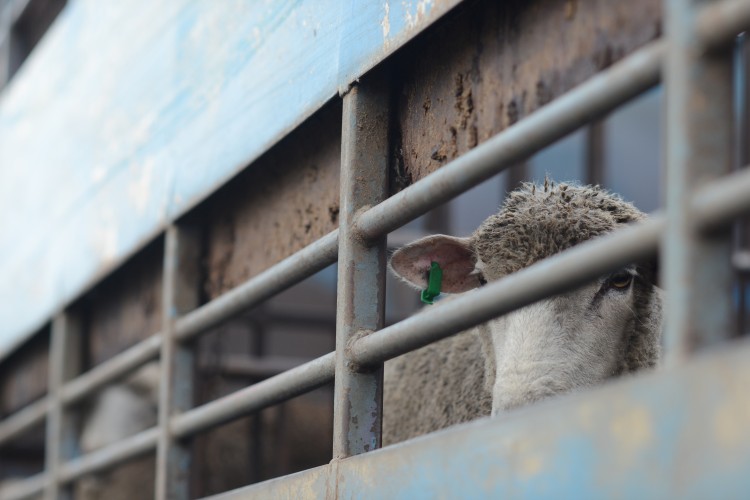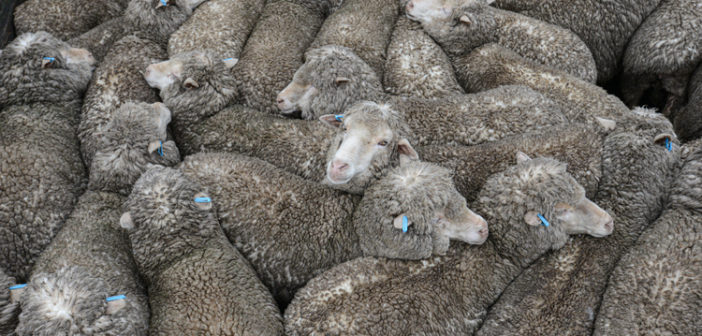Sheep are gentle, docile animals who have been genetically manipulated by the wool industry to produce increasingly high volumes of wool in a relatively short period of time. Before the days of genetically altering them, sheep only grew enough wool to protect themselves from extremes in temperature and then naturally shed their wool when warmer weather arrived. But genetic manipulation by humans for profit has produced breeds of sheep that no longer shed, have unnaturally large coats, and need to be sheared.
Inhumane practices are the norm
Buying wool today supports numerous cruel practices that sheep are subjected to. These practices have become the norm in the wool industry including: “mulesing” (cutting the skin around the tail area); castration, ear-punching and tail docking without anesthesia; and shearing that causes injuries. At the end of their wool production lives, sheep may be shipped in live transport boats to the Middle East, where they experience horrific conditions during transport for weeks on end, and then are slaughtered upon arrival.
Raising sheep for wool is also considered land- and water-intensive, highly polluting, and highly energy inefficient. The wool industry is no different from other industries that use animals to create profits in that the welfare and well-being of the animal—sheep in this case—is routinely compromised and neglected for higher revenues. Money is the top priority.
Every year, millions of sheep on large industrial sheep farms are forced to live in substandard conditions where they are unable to exhibit natural behaviors. Overcrowding breeds disease, infections, and early deaths. Like all factory farms, in order to save money and increase profits, large sheep farms forego providing veterinary and needed medical care and leave the sheep to suffer and die.

After wool, sold for meat
When sheep can no longer be used for wool production, they are sold to the meat industry. The wool industry is a major driver and contributor to the production of lambs for the meat industry. Every year, after sheep are considered “spent” and no longer viable for their wool, they become part of the live export industry in Australia, where roughly 3-4 million sheep are shipped on long, grueling journeys on filthy, cramped transport ships across the ocean from Australia to the Middle East and North Africa. These trips often last for weeks, with many sheep dying during the trip. When they arrive, they are trucked directly to slaughterhouses where animal protection or welfare standards are virtually nonexistent and are slaughtered fully conscious.
Merino sheep endure even more cruelty
Australia produces less than one-third of all the wool used worldwide, but they produce the highest volume of wool of any country in the world. Merino sheep are the most common sheep breed and they have been genetically bred to produce more wool by increasing the surface area of their wrinkly loose skin. For merino sheep, this wrinkly skin produces an unnatural and enormous amount of weight and wool that causes the sheep to become overheated in warm weather months. Because they have no ability to sweat or shed their wool, it’s common for them to suffer heat stroke and heat exhaustion and die. Urine gets caught in the folds and burns their skin, and creates uncomfortable and dangerous skin and urinary tract infections. The urine attracts maggots that lay their eggs in the folds of skin, called “flystrike,” which can end up eating the sheep alive if not treated.
To prevent flystrike, the majority of sheep ranchers perform a cruel and painful procedure called “mulesing,” where they cut off large strips of skin from around the tail area and from the backs of lambs’ legs to prevent the maggot infestations. The surgery is commonly done without any anesthesia, painkillers, or protection to cover the wound, and is rarely followed by antibiotics. Often the skin becomes infected and once this happens, the lambs can die. Since this procedure is considered extremely painful and cruel, there is pressure on the Australian government to find humane alternatives to mulesing. Since 2012, the industry has tried several alternatives, but most have been found to be less effective in preventing flystrike, even if more humane.

Shearers abuse and injure sheep during shearing
Shearers are paid not by the hour, but by the quantity of wool they shear, and as a result, are often aggressive in shearing and shear as fast as they can. As a result, they can end up injuring the sheep. When the injury is severe, instead of providing veterinary care and treatment for the wound, shearers will often kill the sheep. Using sharp electric shears, shearers often gouge the sheep’s skin, accidentally cut off teats or tails, slice the ears, and cause unnecessary pain and suffering for the sheep—all in an effort to produce as much wool as they can in a day.
More sheep sheared means more money made. A skilled and careful shearer can remove the wool in one single large piece, without causing any real distress or injury to the sheep, and the sheep will jump up and just run away. But with the massive flock sizes found on today’s industrial sheep farms throughout Australia, the U.S., Chile, and other countries, many shearers immobilize sheep in uncomfortable, painful positions and shear them too quickly, making mistakes and causing injury and even death.
What you can do
- Buy only ethical, cruelty-free alternatives to wool. Look for animal-free products and vegan wool alternatives, such as cotton, polyester, polyester fleece, microfiber, acrylic, rayon, linen, viscose, modal, bamboo, hemp, synthetic shearling, and other man-made materials. Here’s a great list of cruelty-free fabrics.
- Never buy any of the following wool-based fabrics, which all involve animal cruelty: angora, mohair, cashmere, shearling, shahtoosh, pashmina, or anything with “wool” on the label.
- Ask retailers to carry alternatives to wool and wool-free products.
- Buy sustainable fabrics that cause less environmental destruction.
- Buy ethical and eco-friendly yarn and textiles.
- Read PETA’s PDF on mulesing and live exports to learn more.
- Support the fight against cruelty to sheep by signing up for email alerts and becoming involved with Animals Australia, Stop Live Exports, PETA, and The Humane Society of the United States.
This article was originally posted on the Humane Decisions website.
Featured image: tightly packed sheep at an Australian sale yard. Image credit Jo-Anne McArthur / We Animals





